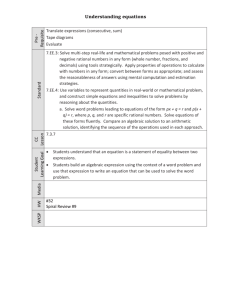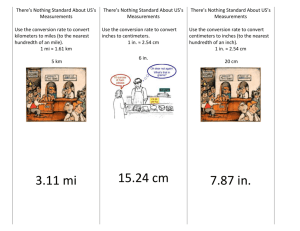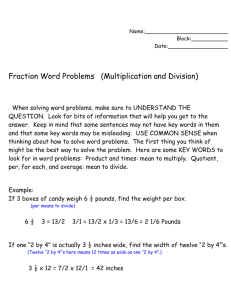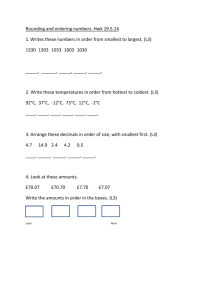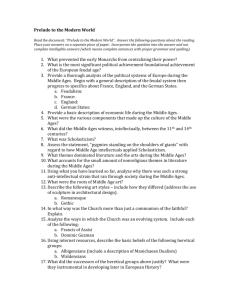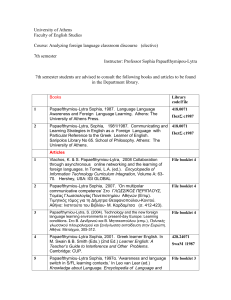Lesson 7 Understanding Equations
advertisement
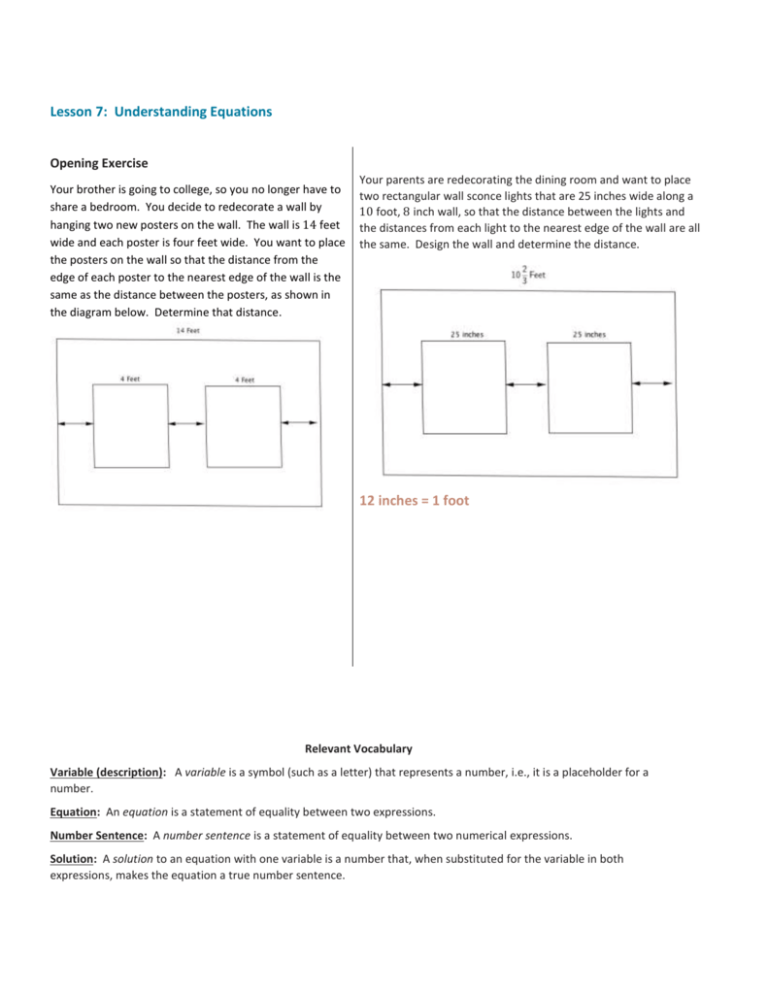
Lesson 7: Understanding Equations Opening Exercise Your brother is going to college, so you no longer have to share a bedroom. You decide to redecorate a wall by hanging two new posters on the wall. The wall is 14 feet wide and each poster is four feet wide. You want to place the posters on the wall so that the distance from the edge of each poster to the nearest edge of the wall is the same as the distance between the posters, as shown in the diagram below. Determine that distance. Your parents are redecorating the dining room and want to place two rectangular wall sconce lights that are 25 inches wide along a 10 foot, 8 inch wall, so that the distance between the lights and the distances from each light to the nearest edge of the wall are all the same. Design the wall and determine the distance. 12 inches = 1 foot Relevant Vocabulary Variable (description): A variable is a symbol (such as a letter) that represents a number, i.e., it is a placeholder for a number. Equation: An equation is a statement of equality between two expressions. Number Sentence: A number sentence is a statement of equality between two numerical expressions. Solution: A solution to an equation with one variable is a number that, when substituted for the variable in both expressions, makes the equation a true number sentence. Let the distance between a light and the nearest edge of a wall be 𝑥 ft. Write an expression in terms of 𝑥 for the total length of the wall, and then use the expression and the length of the wall given in the problem to write an equation that can be used to find that distance. Now write an equation where 𝑦 stands for the number of inches: Let the distance between a light and the nearest edge of a wall be 𝑦 in. Write an expression in terms of 𝑦 for the total length of the wall, and then use the expression and the length of the wall (in inches) given in the problem to write an equation that can be used to find that distance (in inches). What value(s) of 𝑦 makes the second equation true: 24, 25, or 26? Example 1 The ages of three sisters are consecutive integers. The sum of their ages is 45. Find their ages. a. Use a tape diagram to find their ages. b. If the youngest sister is 𝑥 years old, describe the ages of the other two sisters in terms of 𝑥, write an expression for the sum of their ages in terms of 𝑥, and use that expression to write an equation that can be used to find their ages. c. Determine if your answer from part (a) is a solution to the equation you wrote in part (b). Exercise 1. Sophia pays a $19.99 membership fee for an online music store. a. If she also buys two songs from a new album at a price of $0.99 each, what is the total cost? b. If Sophia purchases 𝑛 songs for $0.99 each, write an expression for the total cost. c. Sophia’s friend has saved $118 but isn’t sure how many songs she can afford if she buys the membership and some songs. Use the expression in part (b) to write an equation that can be used to determine how many songs Sophia’s friend can buy. d. Using the equation written in part (c), can Sophia’s friend buy 101, 100, or 99 songs? You may use a calculator. Lesson Summary In many word problems, an equation is often formed by setting an expression equal to a number. To build the expression, it is often helpful to consider a few numerical calculations with just numbers first. For example, if a pound of apples costs $2, then three pounds cost $6 (2 × 3), four pounds cost $8 (2 × 4), and 𝑛 pounds cost 2𝑛 dollars. If we had $15 to spend on apples and wanted to know how many pounds we could buy, we can use the 1 2 expression 2𝑛 to write an equation, 2𝑛 = 15, which can then be used to find the answer: 7 pounds. To determine if a number is a solution to an equation, substitute the number into the equation for the variable (letter) and check to see if the resulting number sentence is true. If it is true, then the number is a solution to the equation. For example, 7 1 1 is a solution to 2𝑛 = 15 because 2 (7 ) = 15. 2 2 Problem Set – Be sure to check your answers on the answer key. 1. 2. Check whether the given value is a solution to the equation. Show work. a. 4𝑛 − 3 = −2𝑛 + 9 𝑛=2 b. 9𝑚 − 19 = 3𝑚 + 1 𝑚= c. 3(𝑦 + 8) = 2𝑦 − 6 𝑦 = 30 10 3 Tell whether each number is a solution to the problem modeled by the following equation. Mystery Number: Five more than −𝟖 times a number is 𝟐𝟗. What is the number? Let the mystery number be represented by 𝑛. The equation is: 3. 5 + (−8)𝑛 = 29. a. Is 3 a solution to the equation? Why or why not? b. Is −3 a solution to the equation? Why or why not? c. What is the mystery number? The sum of three consecutive integers is 36. a. Find the smallest integer using a tape diagram. b. Let 𝑛 represent the smallest integer. Write an equation that can be used to find the smallest integer. c. Determine if each value of 𝑛 below is a solution to the equation in part (b). 𝑛 = 12.5 𝑛 = 12 𝑛 = 11

